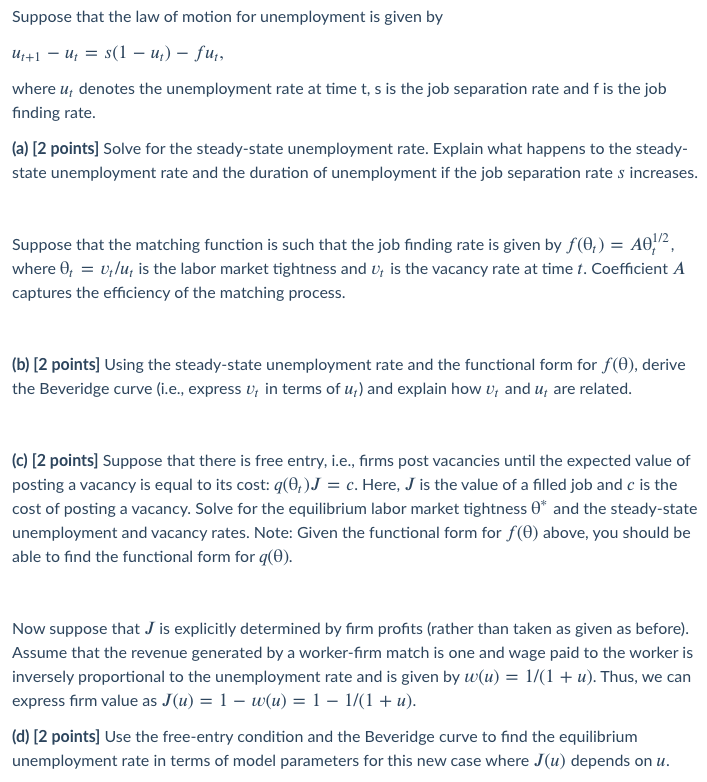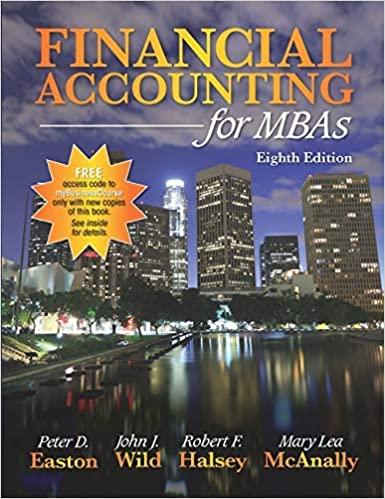
Suppose that the law of motion for unemployment is given by u+1 uy = s(1 u) - fut, where u, denotes the unemployment rate at time t, s is the job separation rate and f is the job finding rate. (a) [2 points] Solve for the steady-state unemployment rate. Explain what happens to the steady- state unemployment rate and the duration of unemployment if the job separation rate s increases. Suppose that the matching function is such that the job finding rate is given by f(0) = AO!!?, where 0, = vlu, is the labor market tightness and v; is the vacancy rate at time t. Coefficient A captures the efficiency of the matching process. (b) [2 points] Using the steady-state unemployment rate and the functional form for f(0), derive the Beveridge curve (i.e., express V, in terms of up) and explain how y, and u, are related. (c) [2 points] Suppose that there is free entry, i.e., firms post vacancies until the expected value of posting a vacancy is equal to its cost: g(0)J = c. Here, J is the value of a filled job and c is the cost of posting a vacancy. Solve for the equilibrium labor market tightness 0* and the steady-state unemployment and vacancy rates. Note: Given the functional form for f(e) above, you should be able to find the functional form for qe). Now suppose that I is explicitly determined by firm profits (rather than taken as given as before). Assume that the revenue generated by a worker-firm match is one and wage paid to the worker is inversely proportional to the unemployment rate and is given by w(u) = 1/(1 + u). Thus, we can express firm value as J(u) = 1 - w(u) = 1 - 1/(1 + u). (d) [2 points] Use the free-entry condition and the Beveridge curve to find the equilibrium unemployment rate in terms of model parameters for this new case where J(u) depends on u. Suppose that the law of motion for unemployment is given by u+1 uy = s(1 u) - fut, where u, denotes the unemployment rate at time t, s is the job separation rate and f is the job finding rate. (a) [2 points] Solve for the steady-state unemployment rate. Explain what happens to the steady- state unemployment rate and the duration of unemployment if the job separation rate s increases. Suppose that the matching function is such that the job finding rate is given by f(0) = AO!!?, where 0, = vlu, is the labor market tightness and v; is the vacancy rate at time t. Coefficient A captures the efficiency of the matching process. (b) [2 points] Using the steady-state unemployment rate and the functional form for f(0), derive the Beveridge curve (i.e., express V, in terms of up) and explain how y, and u, are related. (c) [2 points] Suppose that there is free entry, i.e., firms post vacancies until the expected value of posting a vacancy is equal to its cost: g(0)J = c. Here, J is the value of a filled job and c is the cost of posting a vacancy. Solve for the equilibrium labor market tightness 0* and the steady-state unemployment and vacancy rates. Note: Given the functional form for f(e) above, you should be able to find the functional form for qe). Now suppose that I is explicitly determined by firm profits (rather than taken as given as before). Assume that the revenue generated by a worker-firm match is one and wage paid to the worker is inversely proportional to the unemployment rate and is given by w(u) = 1/(1 + u). Thus, we can express firm value as J(u) = 1 - w(u) = 1 - 1/(1 + u). (d) [2 points] Use the free-entry condition and the Beveridge curve to find the equilibrium unemployment rate in terms of model parameters for this new case where J(u) depends on u







